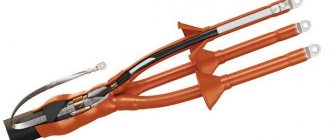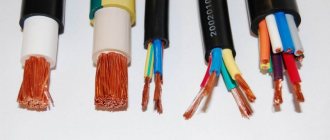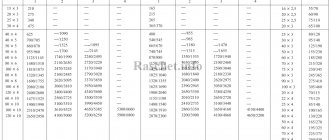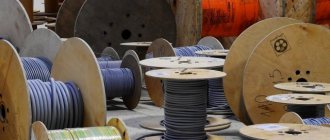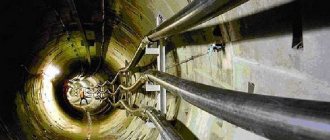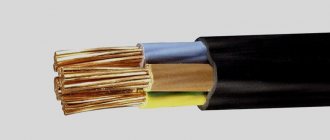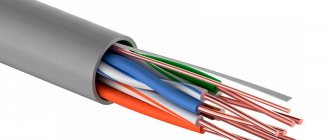Acoustic cable for speakers - how to choose a cross-section?
As strange as it may sound, buying an speaker cable for a speaker is not the easiest thing. There are such a huge number of them on the market and you can buy them in almost any audio equipment store. Just before you buy, evaluate your solvency. Determine how high quality these wires are. Before purchasing, study the manufacturer of the product, as well as the technical specifications. Most people buy wires for acoustics without thinking, they say they will fit any system. But this is completely wrong. Such a choice is not an easy task and must be approached responsibly.
How to calculate an acoustic cable
Speaker cables selection of cross-section
The calculation of an acoustic cable directly depends on its CD. Therefore, it is advisable to first calculate its parameters, and only then decide what dimensions the cable itself will have. Calculating the CDU is quite easy: you need to divide eight Ohms (the initial value of the usual resistance of the emitter) by the specified resistance of the amplifier at the output.
Note. For example, when the amplifier's output resistance is set to 0.01 ohms, its CD is eight hundred, which is normal for high-power amplifiers. Tube amplifiers, as usual, have a higher output impedance and naturally lower CD.
What cable is needed for acoustics
In reality, this type of calculation will become quite approximate, and there are some important factors to take into account:
- First of all, not every speaker will have a starting impedance value of eight ohms;
- No CD calculation, done correctly, can be fully completed if the speaker cable is not taken into account in this equation.
How to choose an speaker cable?
When choosing an audio cable for your acoustics, base it on the following rules:
- If you buy inexpensive speakers, do not think that the wire will be of excellent quality.
- If the manufacturer is popular and well-known, all components, including audio cables, are correctly selected.
- A high-quality wire always has a wide cross-section, this is the only way it can pass enough current.
- The surface must have a varnish coating, this protects against short circuits.
- The sound should not get worse: if the wire is of good quality, then the sound will be better.
- The wire should have an average resistance; the lower the resistance, the better the sound.
- It should be remembered that audio cables made of copper are better. They usually consist of twenty copper wires. Each is separately isolated and they are all collected into one system. Due to the small diameter of the cable, it has little resistance. This makes it possible to transmit a signal at high speed without losing quality.
- A large diameter wire should only be taken if it is no longer than three meters.
cable cross-section
The cable cross-section is one of its characteristics, which says little about its effect on the sound. There are many examples where thin cables outperformed their thick counterparts in sound quality. But you should still avoid connecting acoustics with very thin wires.
The cable cross-section also affects the sound.
Let's begin the educational process...... The output impedance of stone amplifiers is tens of milliohms, and if you connect a thin cable to it, you will kill the damping factor of the speaker-amplifier connection. The woofer will hum due to the self-oscillations associated with the high resistance of the thin wires, but people may like the sound of the diffuser dangling in self-oscillation, which is why the thin (but prayed for) wires played and outplayed the thick wires with low resistance.
material……Important. Although this is also not a guarantee of the right choice. There is an opinion that silver cools the sound, and copper makes it warmer. However, there are many silver-plated cables that are much softer than pure copper cables.
Some find it cold, some feel warm, but in advertising articles for expensive cables it is clearly written that they are neutral and transmit the signal with incredible accuracy without introducing any distortion into it, thereby providing unrivaled stage depth and the finest elaboration of sound details. I respect the opinion of fans of wires that color the sound, but even marketers have realized that the “sound of cables” is a parasitic effect and they themselves try not to focus on this, leaving the discussion of the shortcomings of cables to idle chatter on specialized forums.
The price of a cable partly indicates its quality, but does not at all guarantee that it will suit your sound.
That is, the advice is about nothing.....
Connectors, even very expensive and high-quality ones, are not able to improve the sound. Their purpose is to facilitate connection to terminals.
Connectors have such a parameter as contact resistance, which also participates in the formation of the damping factor, therefore, in the same way as wires, they affect the sound!!!!!! INFLUENCE !!!!!! And professional connectors are designed to make the connection easier, when before a concert everything needs to be connected and then turned off……. and so on hundreds of times. In home equipment, the connection occurs a couple of times a year. Here convenience is the tenth issue, and quality contact is the first and main thing.
Therefore, any cables should be selected only after personal listening in your own system. Recommendations on the forum are just a direction to search.
But I completely agree with this. Having no knowledge of electrical engineering, there is nothing to advise!!!!!
P.S.
That’s interesting, now they’ll troll me up to 20 dB in the rating??????? :))))))))))))))
How to choose the cable cross-section?
Every owner of a speaker system sooner or later asks the question: which cable is better? What should the cable cross-section be? It all depends on the power that will be transmitted. The higher the power is planned to be transmitted, the higher the cross-sectional value should be. Resistance has a significant impact on signal transmission.
This can be explained by the fact that many speakers have low impedance. You can do an experiment. To do this, connect an acoustic cable with a resistance of one ohm to a speaker with a resistance of eight ohms. The load will be equal to the sum of the two indicators. Current and power values drop. In order for the power to be of the required value, it is required that the resistance be no more than five percent of the impedance, if high frequencies are used, and when low, then no more than ten percent.
The ideal wire can be considered the one whose cross-section corresponds to certain indicators and is purchased for a specific system. If the cable does not meet the specifications, you need to select other cross-section indicators. The most common are cables with a cross-section from 2.5 millimeters to four.
As you can see, there is nothing complicated in selecting a section. Follow the rule that a longer wire requires a higher cross-section. And the most common is 2.5 millimeters. From there you need to start selecting a more suitable cable for your speaker system.
Source
conclusions
So which speaker cable should you choose for your speakers? How to choose the cross-section of an acoustic cable for this purpose?
Which cable to choose?
Based on what we already know from what we read earlier, I believe that you can buy any electrical cable or special acoustic wire, of any brand and manufacturer. The main thing is that it matches the required characteristics of the amplifier itself and the speaker system. That is, important parameters: the output power of the amplifier, the impedance of the speaker systems and the length of the wire itself.
Acoustic cables for speakers: what are they and how to choose the cross-section?
- Peculiarities
- Overview of species
- Copper
- Composite
- Combined
- How to choose a section?
- Criterias of choice
- Connection
In order to enjoy the highest sound quality, special attention should be paid to the choice of not only speakers, but also speaker cables for them. On the modern market you can find a huge variety of such products.
Peculiarities
Today, speaker cables and wires for speakers can be purchased almost anywhere (both on the market and in specialized stores or showrooms). At the same time, almost everyone needs an audio cable for acoustics - both amateur and professional.
Speaker cable is an integral element of Hi-Fi systems.
Moreover, in some cases it can come standard with speakers (then the manufacturer selects the most optimal model that meets all the characteristics of the speakers and combines with them almost perfectly). In other cases, the audio cable will have to be purchased separately.
Copper
The choice of copper cable should be approached with special attention. So, before making a direct purchase of a product, you should make sure that the copper speaker wire has the length necessary for correct functioning. It is believed that long copper wires should have a small diameter (especially if the resistance values are not too high).
In such a situation, the sound quality that will come from the speaker will be at the highest level.
The required volume level will also be ensured.
When choosing a copper cable, it is important to make sure that it has the appropriate markings from the manufacturer, which indicates the company that produced the cable. If there are no such marks, then we can conclude that this product is a fake - accordingly, you should immediately refuse to purchase it, since there are no guarantees regarding the sound quality and the duration of the cable.
Due to the fact that copper cables are the most popular type of product, they are produced in large quantities, and they, in turn, are divided into several independent categories. Therefore, before purchasing, it is important to make sure that you are purchasing the acoustic version - there should be a special mark about this.
Copper cables can be made from either oxygen-free or monocrystalline copper. You should also pay close attention to this factor. In addition, you should give preference to thin wires, as they ensure high quality sound transmitted from the speakers.
There are 3 types of copper from which audio cables are made: TPC, OFC and PSOSS. These varieties differ in sound quality and, accordingly, cost. So, if you want to buy an acoustic cable for speakers made of budget copper, then you should give preference to the TPC type. For oxygen-free systems belonging to the middle class, OFC products are suitable. At the same time, the highest quality cables are those made of pure copper - RSOSS.
Composite
In addition to copper, you can also find composite varieties on the market. Despite the fact that they contain a large percentage of copper, there are also other components.
Thus, a popular variety is the inner part of which is made of copper, and the outer shell is made of some metal alloy.
How to choose a section?
The wire cross-section is the most important indicator that you should pay primary attention to when choosing an acoustic cable.
If you visually imagine an acoustic cable in the form of a funnel, through which power from the amplifier is transferred to the speaker system, then the cross-section in such an imaginary exercise will act as the diameter of the hole in this funnel. Thus, if you select a cable that has an insufficient cross-sectional width, the system will not receive the power necessary for full operation. Such a drawback will be audible - the sound will not be dynamic, and the lack of necessary bass will also be obvious.
In order to choose the correct cross-section, it is necessary to make the necessary calculations, which will be different for each individual cable. If we talk about the average permissible value, then for a medium-power speaker system of the floor-standing category a cross-section of 2.5 mm will be sufficient.
Acoustic cable
Speaker cable is the cable that runs from the power amplifier or receiver to the speaker systems.
Why is it more correct to say cable rather than speaker wire?
A wire is a single conductor consisting of one strand (wire) or twisted several thin wires (stranded wire).
A cable is several wires in a common sheath or with sheaths combined with each other.
The shield is the outer shell that protects against electromagnetic interference. It is not used for speaker cables due to the high levels of signals passing through the cable. The useful signal in it is disproportionately stronger than the level of interference induced on the cable.
The formula for the resistance of an acoustic cable (copper pair) is Rcable:
Rcab=0.0167 * 2 / S * L,
where S is the cable cross-section, mm2;
L—cable length, meters.
Speaker cable resistance table (copper pair), Ohm
| Section\Length | 1m | 2m | 5m | 10m |
| 0.5 mm.sq. | 0,067 | 0,134 | 0,334 | 0,668 |
| 0.75 mm.sq. | 0,045 | 0,089 | 0,223 | 0,445 |
| 1.5 mm.sq. | 0,022 | 0,045 | 0,111 | 0,223 |
| 2.5 mm.sq. | 0,013 | 0,027 | 0,067 | 0,134 |
| 4.0 mm.sq. | 0,008 | 0,017 | 0,042 | 0,084 |
In the cable resistance formula, as in the table, it is taken into account that the cable consists of two wires, each of which contributes its share of resistance.
Source
Criterias of choice
Selecting an acoustic cable for speakers is an important and responsible task that should be approached with the utmost seriousness and responsibility. It is best to rely on technical factors. Let's look at some of them:
- when purchasing a cable to connect speakers together, you should not automatically assume that you will purchase a high-quality product; be prepared even for a negative outcome;
- give preference to products manufactured by proven, popular and reputable companies among users - such products will meet all international standards;
- when choosing a cable cross-section, it is best to choose one of sufficient width - this is necessary so that a sufficient amount of current can pass through it;
- if you are in doubt about which cable to take, then give preference to the option that is coated with varnish on top (the whole point is that such a coating will help protect you from short circuits);
- When checking the cable's performance, you should make sure that the sound quality does not deteriorate over time;
- As for resistance indicators, they must have values that exceed the arithmetic average (remember that resistance affects the level of signal transmission quality), etc.
Prize-winners
Speaker cable 12ga
Of course, a speaker system without proper speaker cables will not sound as it should. That is why you should choose the most favorable option for your car. Now let's look at some of them:
- Atlas Equator 2.0 OFC. A meter of this conductor costs $18. This is quite a lot, but, nevertheless, its quality is not bad at all. With its help you can achieve excellent sound for absolutely any composition. In some cases it is quite modest, but, nevertheless, it is full of various details and nuances.
Atlas Equator 2.0 OFC
Of course, this may not be to everyone's taste after the first listen. But if you listen closely, this sound will subsequently appeal to anyone. The most significant feature of this cable is that it makes it easy to find balance. While all cables change their sound in different speakers (this depends on the material from which they are made). Atlas remains neutral.
Speaker cable audio note
Note: the cable can be connected in any convenient way.
- AudioQuest FLX-SLiР 14/4. The cost of the cable is relatively low: only $9 per meter of length. The main advantage is that the cable is very flexible. Most of the cables, according to the “flexibility” criterion, completely failed.
AudioQuest FLX-SLiР 14/4
Because of this, they could not be easily installed. In this case, it is very difficult to go around the corner of the counter. In addition, it provides almost ideal sound: it is uniform, organized, smooth, balanced. The rhythm delivery is also flawless. Therefore, listening to a track with such a cable will only bring pleasure.
Stinger speaker cable
- Chord Carnival SilverScreen. A meter of cable costs $11. Compared to previous versions, this model has some, albeit minor, disadvantages. The sound of the melody is disorganized. However, in general the cable is very good. It’s just that it first appeared a long time ago, so it’s hard for it to maintain an equal position with its competitors.
Speaker cable w
